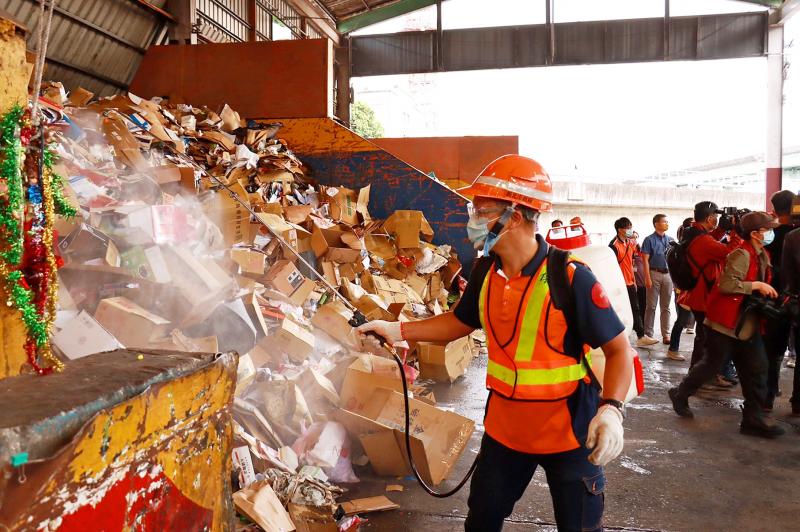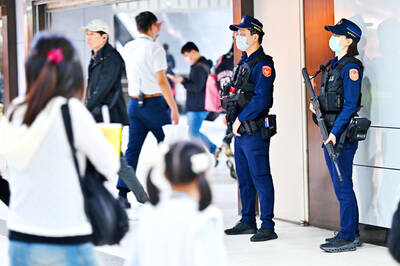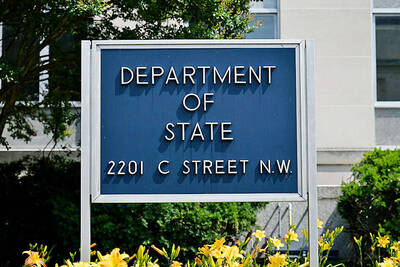Workers can turn in their COVID-19 isolation notification form any time within 30 days after the end of their isolation or quarantine period, the Ministry of Labor (MOL) said yesterday, as the nation recorded 85,720 new domestic cases.
The measure, which took effect yesterday, applies to employees who could not immediately give their employers official health notices requiring them to quarantine or isolate due to system delays, which have led to an uptick in labor disputes, Deputy Minister of Labor Wang Shang-chih (王尚志) said at the Central Epidemic Command Center (CECC) news briefing.
Employees who are confirmed to have COVID-19 can apply for sick or injury leave, while those in self-isolation after being listed as a contact can apply for pandemic prevention leave, he said.

Photo: Lin Hsin-han, Taipei Times
Those in the latter category who display no symptoms are free to return to work, should they wish to do so, he said.
Those who need to stay home to care for an isolating child can request family care leave or pandemic prevention care leave, he said.
The COVID-19 certification Web site would on Wednesday next week be upgraded to reduce the waiting time for quarantine or isolation notices from 24 hours to between five and 10 hours, Minister of Health and Welfare Chen Shih-chung (陳時中) said.
Chen, who also heads the CECC, said that the quarantine notification system would be separated from the National Infectious Disease Reporting System to enhance their efficiency.
The nation yesterday recorded 85,720 new domestic COVID-19 cases and 49 deaths, down slightly from the 90,378 new infections and 59 deaths reported a day earlier, the CECC said.
The 49 deaths were people in their 30s to 90s, the CECC said, adding that 21 of them were unvaccinated, while 14 had received three doses of a COVID-19 vaccine.
All but one had chronic illnesses or severe diseases such as cancer, it said.
The youngest people who died were two men and a woman in their 30s, who were all unvaccinated and had a history of underlying diseases, CECC data showed.
On Thursday, the CECC announced that people who have recovered from a COVID-19 infection are now exempt from any contact listing for the three-month period after they first tested positive.
This means they would not have to follow isolation or self-health monitoring rules if listed as a contact, Centers for Disease Control Deputy Director-General Philip Lo (羅一鈞), deputy head of the CECC’s medical response division, said at the news briefing.
The protocol has been changed based mainly on research that shows COVID-19 immunity can last for at least three months after an infection, Lo said.
Furthermore, people such as healthcare workers and medical staff who have recovered are highly likely to come into frequent contact with COVID-19 patients, which makes it impractical to list such workers as contacts while they have immunity, Lo said.
Over the past two years, there have been only 457 confirmed COVID-19 reinfections in Taiwan, he said, citing data valid as of Monday.
However, people who have recovered from COVID-19 but develop symptoms of the disease after coming in contact with an infected person are advised to get a rapid test or a polymerase chain reaction test, Lo said, adding that if they test negative, they would be exempted from any contact listing.

A car bomb killed a senior Russian general in southern Moscow yesterday morning, the latest high-profile army figure to be blown up in a blast that came just hours after Russian and Ukrainian delegates held separate talks in Miami on a plan to end the war. Kyiv has not commented on the incident, but Russian investigators said they were probing whether the blast was “linked” to “Ukrainian special forces.” The attack was similar to other assassinations of generals and pro-war figures that have either been claimed, or are widely believed to have been orchestrated, by Ukraine. Russian Lieutenant General Fanil Sarvarov, 56, head

SAFETY FIRST: Double the number of police were deployed at the Taipei Marathon, while other cities released plans to bolster public event safety Authorities across Taiwan have stepped up security measures ahead of Christmas and New Year events, following a knife and smoke bomb attack in Taipei on Friday that left four people dead and 11 injured. In a bid to prevent potential copycat incidents, police deployments have been expanded for large gatherings, transport hubs, and other crowded public spaces, according to official statements from police and city authorities. Taipei Mayor Chiang Wan-an (蔣萬安) said the city has “comprehensively raised security readiness” in crowded areas, increased police deployments with armed officers, and intensified patrols during weekends and nighttime hours. For large-scale events, security checkpoints and explosives

PUBLIC SAFETY: The premier said that security would be tightened in transport hubs, while President Lai commended the public for their bravery The government is to deploy more police, including rapid response units, in crowded public areas to ensure a swift response to any threats, President William Lai (賴清德) said yesterday after a knife attack killed three people and injured 11 in Taipei the previous day. Lai made the remarks following a briefing by the National Police Agency on the progress of the investigation, saying that the attack underscored the importance of cooperation in public security between the central and local governments. The attack unfolded in the early evening on Friday around Taipei Main Station’s M7 exit and later near the Taipei MRT’s Zhongshan

REBUFFED: In response to Chinese criticism over recent arms sales, Washington urged Beijing to engage in meaningful dialogue instead of threats and intimidation Washington’s long-term commitment to Taiwan would not change, the US Department of State said yesterday, urging Beijing to stop pressuring Taiwan and engage in meaningful bilateral dialogues. The remarks came in response to a backlash from Beijing about Washington’s latest approval of arms sales to Taiwan. The US Defense Security Cooperation Agency said in a statement on Wednesday that the Taipei Economic and Cultural Representative Office in the US has asked to purchase an arms package, including Tactical Mission Network Software; AH-1W helicopter spare and repair parts; M109A7 self-propelled howitzers; HIMARS long range precision strike systems; tube-launched, optically tracked, wire-guided missiles; Javelin